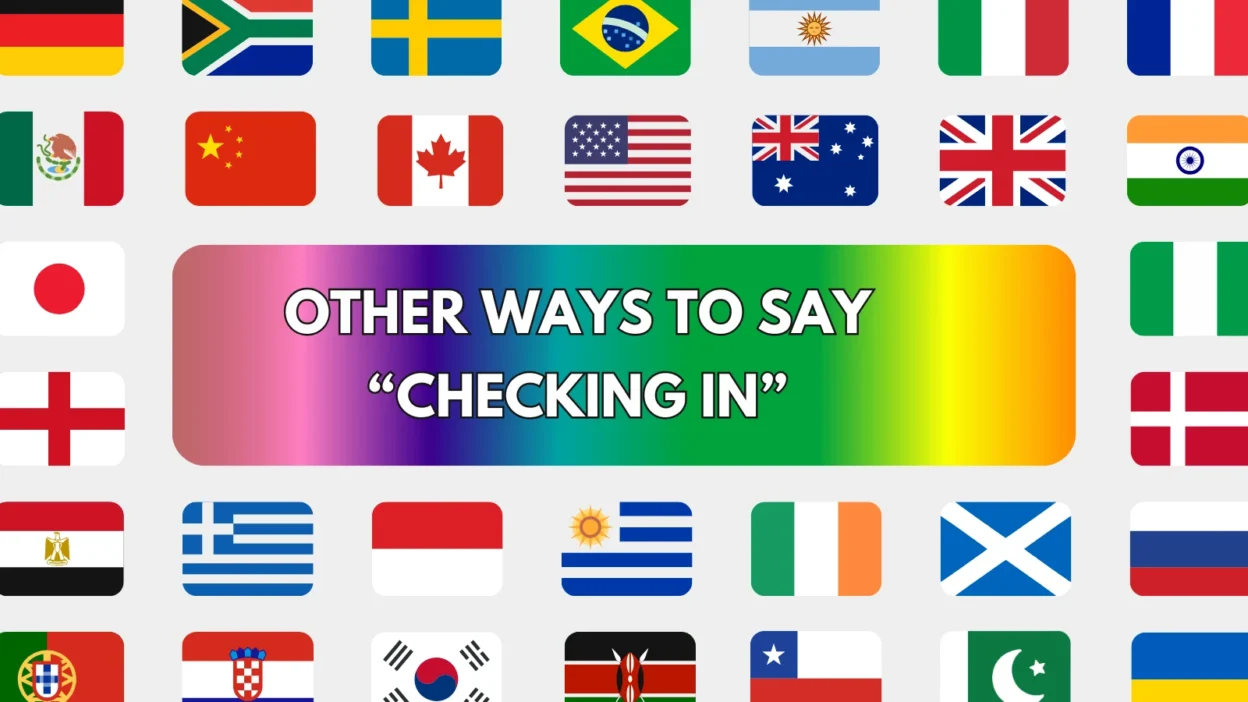“Checking in” is a friendly phrase we often use to start conversations, follow up on tasks, or show care and concern for someone. Whether you’re writing a professional email, sending a casual message, or expressing emotional support, having alternative ways to say “checking in” helps you sound more thoughtful, polished, and appropriate for any context.
Here are 25 effective alternatives to “checking in”, each with its meaning, a detailed explanation, usage example, ideal context, and tone.
1. Just Following Up
Meaning
Gently reminding someone or seeking an update.
Detailed Explanation
Used in emails or messages when waiting for a response or progress on something.
Scenario Example
Just following up to see if you had a chance to review the proposal.
Best Use
Professional communication, project updates.
Tone
Polite, professional.
2. Touching Base
Meaning
Making brief contact to reconnect or get a quick update.
Detailed Explanation
Often used in both business and casual conversations.
Scenario Example
Just touching base to see how everything’s going with the new software.
Best Use
Casual or workplace communication.
Tone
Friendly, conversational.
3. Reaching Out
Meaning
Initiating contact or communication.
Detailed Explanation
Versatile and respectful, often used in both emotional support and business contexts.
Scenario Example
I’m reaching out to see how things are going on your end.
Best Use
Email, personal support messages.
Tone
Warm, considerate.
4. Wanted to See How You’re Doing
Meaning
Expresses care or interest in someone’s well-being.
Detailed Explanation
Ideal for personal check-ins, especially with friends or family.
Scenario Example
Hey! Just wanted to see how you’re doing lately.
Best Use
Texts, emotional check-ins.
Tone
Caring, sincere.
5. Following Up on Our Last Conversation
Meaning
Brings attention to a previously discussed topic.
Detailed Explanation
Keeps communication clear and consistent in ongoing discussions.
Scenario Example
Following up on our last conversation—did you get a chance to finalize the outline?
Best Use
Workplace emails, collaborative tasks.
Tone
Professional, respectful.
6. Circling Back
Meaning
Returning to a topic that needs closure or attention.
Detailed Explanation
Often used in business emails as a gentle reminder.
Scenario Example
Circling back to see if you had any updates on the contract.
Best Use
Corporate or sales communication.
Tone
Courteous, efficient.
7. Wanted to Follow Up With You
Meaning
A softer version of “following up” that shows interest.
Detailed Explanation
More personal, useful for one-on-one communication.
Scenario Example
Just wanted to follow up with you on how your presentation went.
Best Use
Friendly professional exchanges.
Tone
Supportive, professional.
8. How Are Things Going?
Meaning
Inquires generally about someone’s progress or well-being.
Detailed Explanation
Simple and casual way to start a check-in conversation.
Scenario Example
Hey, how are things going with your new job?
Best Use
Casual messages, friendly emails.
Tone
Relaxed, personable.
9. I Wanted to Check in on That
Meaning
Asks for an update on a specific item or task.
Detailed Explanation
Direct and clear while remaining polite.
Scenario Example
I wanted to check in on that budget report—any progress?
Best Use
Team projects, workplace settings.
Tone
Professional, polite.
10. Hope Everything’s Going Well
Meaning
Expresses care while subtly prompting a response.
Detailed Explanation
A kind opener for any type of follow-up.
Scenario Example
Hope everything’s going well—just wondering if you need any help with the task.
Best Use
Emails, friendly check-ins.
Tone
Supportive, kind.
11. Just Wanted to Touch Base
Meaning
Initiates contact without urgency.
Detailed Explanation
Used to reconnect without pressure or expectations.
Scenario Example
Just wanted to touch base and see how you’re doing after the move.
Best Use
Personal or light professional chats.
Tone
Casual, caring.
12. Letting You Know I’m Here
Meaning
Offers presence or support, especially during hard times.
Detailed Explanation
Shows emotional availability rather than requesting something.
Scenario Example
Just letting you know I’m here if you ever want to talk.
Best Use
Emotional support messages.
Tone
Warm, empathetic.
13. How Are Things Coming Along?
Meaning
Inquires about the progress of a project or situation.
Detailed Explanation
Casual way to check in without sounding pushy.
Scenario Example
How are things coming along with the fundraising campaign?
Best Use
Project updates, ongoing tasks.
Tone
Friendly, cooperative.
14. Wanted to Hear How You’re Doing
Meaning
Sincerely interested in someone’s state or progress.
Detailed Explanation
Often used to maintain relationships or express concern.
Scenario Example
Hey! Wanted to hear how you’re doing—hope the trip was amazing!
Best Use
Friends, clients, colleagues.
Tone
Thoughtful, warm.
15. Wondering If You Had a Chance To…
Meaning
Checks if a task has been completed or reviewed.
Detailed Explanation
Keeps the tone non-demanding and respectful.
Scenario Example
Just wondering if you had a chance to look over the latest draft.
Best Use
Polite reminders, professional follow-ups.
Tone
Gentle, professional.
16. Just Wanted to Say Hi and Check In
Meaning
Combines greeting with follow-up in a friendly tone.
Detailed Explanation
Balances casual connection and purpose.
Scenario Example
Hi! Just wanted to say hi and check in on how your week’s going.
Best Use
Casual messages, friendly work culture.
Tone
Lighthearted, personable.
17. Wanted to See How Things Are Progressing
Meaning
Inquires about ongoing developments or changes.
Detailed Explanation
Best for mid-stage project discussions or planning.
Scenario Example
Wanted to see how things are progressing on your end with the app redesign.
Best Use
Work updates, client follow-ups.
Tone
Professional, constructive.
18. Checking to See If You Need Anything
Meaning
Offers help or availability.
Detailed Explanation
Very considerate and service-oriented check-in.
Scenario Example
Just checking to see if you need anything from me before the big day.
Best Use
Customer support, team collaboration.
Tone
Helpful, kind.
19. Thought I’d Reach Out
Meaning
Initiates a message without urgency or pressure.
Detailed Explanation
A light and open-ended way to restart communication.
Scenario Example
Hey, thought I’d reach out and see how things are going with your move.
Best Use
Friendships, casual emails.
Tone
Relaxed, warm.
20. Hoping to Hear from You Soon
Meaning
Encourages a response in a gentle way.
Detailed Explanation
Often used to close emails or follow-up messages.
Scenario Example
Just wanted to follow up—hoping to hear from you soon!
Best Use
Email sign-offs, polite reminders.
Tone
Friendly, expectant.
21. Just Checking on the Status
Meaning
Requests an update on progress or completion.
Detailed Explanation
Professional and concise when tracking timelines.
Scenario Example
Just checking on the status of the invoice we discussed last week.
Best Use
Work emails, ongoing tasks.
Tone
Direct, respectful.
22. How Are Things on Your End?
Meaning
Asks for an update or feedback.
Detailed Explanation
Invites dialogue and shares interest in someone else’s side of the situation.
Scenario Example
How are things on your end with the partnership deal?
Best Use
Collaborative emails, peer communication.
Tone
Neutral, inclusive.
23. Wanted to See If Everything’s Okay
Meaning
Checks in with concern, especially if communication has gone silent.
Detailed Explanation
Shows empathy while giving space.
Scenario Example
Haven’t heard from you in a while—wanted to see if everything’s okay.
Best Use
Concerned outreach, delays in response.
Tone
Caring, understanding.
24. Wondering If You Need Any Help
Meaning
Asks if someone could use assistance or support.
Detailed Explanation
Great for teamwork and collaboration.
Scenario Example
Wondering if you need any help with the final steps of the project.
Best Use
Team projects, leadership roles.
Tone
Supportive, proactive.
25. Dropping You a Quick Note
Meaning
Sends a brief and casual message or follow-up.
Detailed Explanation
Best for informal emails or texts with minimal intrusion.
Scenario Example
Just dropping you a quick note to see how the job search is going.
Best Use
Light follow-ups, casual emails.
Tone
Friendly, simple.
Conclusion
Using “checking in” is helpful, but these 25 thoughtful and flexible alternatives can keep your communication varied, clear, and well-matched to the context. Whether you’re offering help, asking for updates, or simply reconnecting, these phrases let you express yourself in more meaningful and effective ways.




